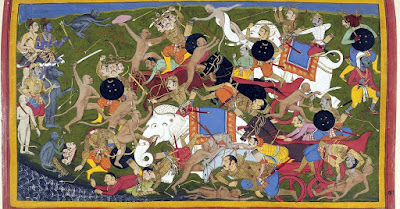The Victorian Marriage Plot And Indian Matchmaking- A Comparative Study
INTRODUCTION
Marriage aided by matchmaking is the most basic traditional institution of human life around the world. In the olden days, marriage was based on the strategic alliance of the Kings. The Anglo-Saxon society or the Indian janapadas extending their belts to become mahajanapadas saw ties to establish peaceful relations by acquiring a territory. Marriage, especially in Hindu custom is a ' sanskara ' or purificatory ceremony obligatory for every Hindu. It is a sacred institution in India marking a turning point in an individual's life as he enters the second important phase or ashram of his life- the 'Grahasthyaashram'.
ALLIANCE TO MUTUAL CONSENT
However, in 1140 the Benedictine monk Gratian brought the concept of consent. From here on, there was more to marriage and matchmaking than just land or property. For instance, the marriage of Dushyanta and Shakuntala is an example of swayamvara.
We have instances of a matrilocal marriage in the Indus Valley Civilization, practices of polygamy, polyandry and swayamvara in the Hindu epics Ramayana and Mahabharata. However, Vedic literature generally endorsed monogamy and was considered the best practice of the highest virtue.
As Vedic Age evolved to orthodox Hinduism, Manuvad gained prominence. It attacked the Vedic systems, decried Gandharva variant as promiscuous while stripping women of traditional independence by permanently placing them in male custodianship.
THE VICTORIAN MARRIAGE PLOT
The marriage plot was the most prevalent genre of the Victorian era. The matchmakers in the British marriage plots across the nineteenth century stand at the nexus of several negotiations.
. Now, given a marginalized position in the Victorian narrative, the matchmakers shoulder and juggle the collective ideologies of romantic fulfilment, personal liberty, domestic womanhood in bringing complement alignments.
Matchmaking is the primary action and courtship dominates the plot throughout the century. The omniscience of matchmakers is evident in the works of Jane Austen, Maria Edgeworth, Margaret Oliphant and such others.
Also, Austen offered a biting yet hilarious social satire to the public attitudes of matchmaking.
Austen believed in the concept of love and her contempt for matchmaking on the mercenary ground is evident where Mrs Bennet( Pride and Prejudice) eyes for money and handsome soldiers. She sends her eldest daughter to her suitor's home on horseback, " because it seems likely to rain; and then you must stay all night". Regency dances in the novel offered many matchmaking opportunities too.
Similarly, Mrs Stanhope( a character in Maria Edgeworth's Belinda) insists on financial motivations as a base for marriage decisions and dismisses Belinda's desire for a husband she can love. Mrs Stanhope portrays commercial strategies to matchmaking with dire warnings of the miserable existence of penniless spinster. Belinda encountering different philosophies of marriage settles in favour of the ideal prudential romantic marriage.
THE MODERN ATTITUDE
In an era of the rising ideology of romantic marriages, the matchmaker represents the communal courtship of the past. But, marriages in India still influence youth to set aside their free-spirited outlook to follow the well-trodden path of arrange marriage. The arrangement of bringing two families closer is the idea that everybody endorses: the cultural definition of marriage is a family affair, rather than an individual enterprise.
The deep stratification along the lines of caste, hierarchy and education make the young feel relieved that their parents would select the best from the available pool. The seeds of an authority figure are sowed right from childhood. The conflict in setting aside traditional Indian customs over American dating culture is well-depicted in the American sitcom The Big Bang Theory through the character Rajesh Koothrapalli.
In mid-July, Netflix dropped the 8-episode series Indian Matchmaking unapologetically and explicitly owning centuries-old prejudices. The show even fails to acknowledge that non-binary people exist and they might want and make great partners too.
It presents our loneliness, but the solution offered is a " compromise". The confusion and anger remind us of Jo March in Little Women where she says:
" Women.... They have minds and they have
souls as well as just hearts
...they have got ambition....
And i am sick of people saying
that love is just all a woman is fit for."
But then she agonisingly utters, " But I'm so lonely."
The show not only resonates the Victorian attitude but sends ripples across the urban Indians who pretend what marriage is not about.
MATCHMAKING, AN INSTITUTE? YES!
The Matchmaking Institute, established in 2003, is the only school in the US accredited by the state of New York to provide certifications to matchmakers from all over the world. Academics and practitioners in sexology and marriage counselling have devised methods to maximise matchmaking successes. The notable American Clinical psychologist, Neil Clark Warren is the co-founder of Harmony and Compatible Partners. Hugo Schmale and Claus Wedekind propose genetics as the basis of matchmaking. Helen Fisher, an American anthropologist in her book, Why We Love: The Nature and Chemistry of Romantic Love propose that love can start with any of these three feelings: lust, attraction and attachment.
CONCLUSION
A comparative study of marriage and matchmaking attitudes in the two cultures come with a similar notion of marrying into wealth. The obsession with status was evident in the analysis undertaken by The Times Of India where " high status" was mentioned 1,532 times in matrimonial ads. The registration of daughters as early as 22 or so reek of a mindset firmly embedded in the Victorian age. The reduction of the self with age corroborates the sickening belief that a woman's greatest qualification is her beauty. The running genre of the Victorian marriage plot and its enforced stereotypes has still a strong footing in the Indian matchmaking landscape.



Comments
Post a Comment